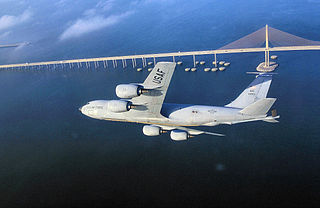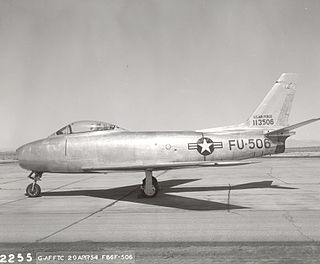
The 72nd Air Base Wing is a United States Air Force unit assigned to the Air Force Sustainment Center at Tinker Air Force Base, Oklahoma. It has been the host unit at Tinker since activating there on 1 October 1994.

The 10th Missile Squadron is a United States Air Force unit. It is assigned to the 341st Operations Group, stationed at Malmstrom Air Force Base, Montana. The squadron is equipped with the LGM-30G Minuteman III Intercontinental ballistic missile, with a mission of nuclear deterrence.

The 12th Missile Squadron is a United States Air Force unit. It is assigned to the 341st Operations Group, stationed at Malmstrom Air Force Base, Montana. The squadron is equipped with the LGM-30G Minuteman III intercontinental ballistic missile, with a mission of nuclear deterrence.

The 970th Airborne Air Control Squadron is part of the 513th Air Control Group at Tinker Air Force Base, Oklahoma. It operates the Boeing E-3 Sentry aircraft conducting airborne command and control missions.

The 25th Attack Group is an active United States Air Force unit, stationed at Shaw Air Force Base, South Carolina. It was activated in February 2018 as a geographically separate unit to operate unmanned aerial vehicles and is assigned to the 432d Wing, which is located at Creech Air Force Base, Nevada. As of 2020, the group manages five General Atomics MQ-9 Reaper attack squadrons, as well as the 25th Operations Support Squadron, which provides intelligence, weather, and administrative support.
Aguadulce Army Airfield is a former United States Army Air Forces World War II airfield in Panama used as part of the defense of the Panama Canal. It was closed on 1 March 1948.

Scarlett Martínez International Airport, also known as Río Hato Airport, is an international airport serving Río Hato, a town in the Coclé Province of Panama. The airport is 3 kilometres (2 mi) east of Río Hato.

The VI Bomber Command was a military formation of the United States Army Air Forces. Its last assignment was with Sixth Air Force. It was based throughout its service at Albrook Field, in the Panama Canal Zone. It was inactivated on 1 November 1946.

The 4th Reconnaissance Squadron is an active United States Air Force unit, assigned to the 319th Operations Group and stationed at Andersen Air Force Base, Guam, from which it operates RQ-4 Global Hawk unmanned vehicles. It was activated there in July 2020.

The 35th Bombardment Squadron is an inactive United States Air Force unit. It was activated in January 1940 as the United States built up its armed forces prior to World War II. In the fall of 1941, it deployed to the Caribbean and, following the attack on Pearl Harbor engaged in antisubmarine patrols. Following the transfer of the land based antisubmarine mission to the Navy, and with the lessening of threats to the Panama Canal, the squadron returned to the United States, where it was disbanded in June 1944.

The Trinidad Wing, Antilles Air Command is an inactive United States Air Force unit. Its last assignment was with Antilles Air Command at Waller Field, Trinidad. It was disbanded on 15 March 1944.

The 7th Reconnaissance Squadron is a squadron of the United States Air Force. It is assigned to the 319th Operations Group and is stationed at Naval Air Station Sigonella, Sicily, Italy.

The 74th Reconnaissance Squadron is an active United States Air Force unit, part of the 9th Reconnaissance Wing at Beale Air Force Base, California. The squadron was first active during World War II as the 74th Aero Squadron. In 1933 it was consolidated with the 74th Pursuit Squadron, which had been organized as a reserve training organization in 1927, activating in the Panama Canal Zone, where it served during World War II as the 74th Bombardment Squadron.

The 44th Reconnaissance Squadron is a unit of the United States Air Force's 432nd Wing, Air Combat Command stationed at Creech Air Force Base, Nevada, where it operates unmanned aerial vehicles. The squadron is assigned to the 432nd Operations Group, and has been reported to operate the Lockheed Martin RQ-170 Sentinel.

The 319th Operations Group is a United States Air Force unit assigned to 319th Reconnaissance Wing, Air Combat Command. It is stationed at Grand Forks Air Force Base, North Dakota operating RQ-4 Global Hawk remotely piloted aircraft (RPA) in the intelligence, surveillance and reconnaissance (ISR) role.

The 6th Operations Group is the operational flying component of the 6th Air Refueling Wing, stationed at MacDill Air Force Base, Florida.

The 395th Tactical Missile Squadron is a United States Air Force unit. It has not been active under that name.

The 50th Fighter-Bomber Squadron is an inactive United States Air Force unit. It was last assigned to the 319th Fighter-Bomber Group at New Orleans Naval Air Station, Louisiana, where it was inactivated on 16 November 1957.

The 32d Air Expeditionary Group is a provisional unit of the United States Air Force (USAF). It is assigned to United States Air Forces in Europe (USAFE) to activate or inactivate at any time. It was last active as the 32d Air And Space Operations Center in December 2006 at Ramstein Air Base, Germany.

The 51st Bombardment Squadron, Light is an inactive squadron of the United States Air Force last based at Birmingham Municipal Airport, Alabama. The squadron served on antisubmarine patrol early in World War II, then as a training unit until it was disbanded in 1944.




















